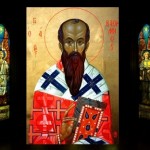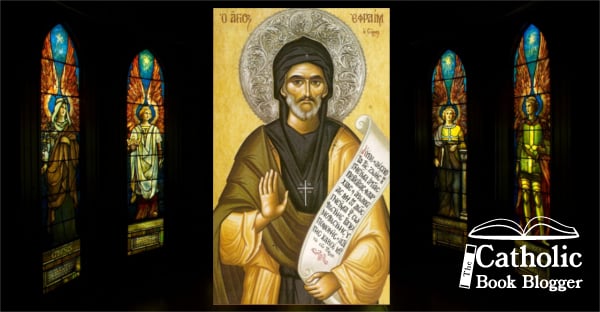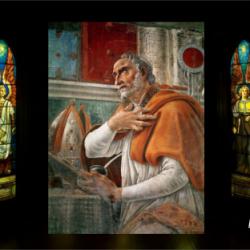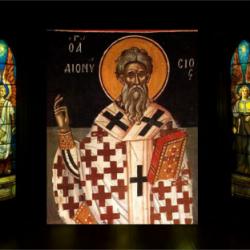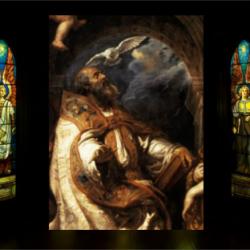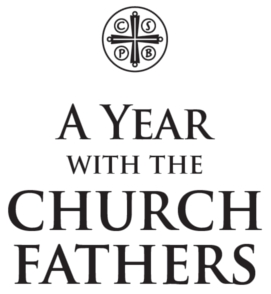 Welcome to a new and exciting feature here at The Catholic Book Blogger. Through the cooperation of author Mike Aquilina and permission of publisher Saint Benedict Press, I am pleased to bring you A Year with the Church Fathers. These daily meditations are taken directly from the book of the same name. This is a book I have grown to love and I use it often.
Welcome to a new and exciting feature here at The Catholic Book Blogger. Through the cooperation of author Mike Aquilina and permission of publisher Saint Benedict Press, I am pleased to bring you A Year with the Church Fathers. These daily meditations are taken directly from the book of the same name. This is a book I have grown to love and I use it often.
In fact, I like it so much I wanted to share it with you, my readers in a special way.
I firmly believe that the Church Fathers are an excellent resource on Catholic Church history. These early Christians nurtured the seed Christ and the Apostles planted which has grown into the flourishing Church we are a part of today. So come visit daily and soak up the richness of our Faith from those who helped build it.
From the publisher:Times change, but human nature does not. Neither do the daily struggles that all Christians experience in their walk with the Lord. Today as two thousand years ago we fight anger, pride, lust, spiritual sloth. Now as then we strive to be more diligent in prayer, more faithful to the commandments, more patient and charitable toward others. And in our time, no less than in the earliest centuries of Christianity, we need wise guidance to direct us on the road to holiness.
In A Year with the Church Fathers, popular Patristics expert Mike Aquilina gathers the wisest, most practical teachings and exhortations from the Fathers of the Church, and presents them in a format perfect for daily meditation and inspiration. The Fathers were the immediate inheritors of the riches of the Apostolic Age, and their intimacy with the revelation of Jesus Christ is beautifully evident throughout their theological and pastoral writings: a profound patrimony that is ours to read and cherish and profit from.
Learn to humbly accept correction from St. Clement of Rome. Let Tertullian teach you how to clear your mind before prayer. Read St. Gregory the Great and deepen your love for the Eucharist. Do you suffer from pain or illness? St. John Chrysostom’s counsels will refresh you. Do you have trouble curbing your appetite for food and other fleshly things? St. John Cassian will teach you the true way to moderation and self-control.
A Year with the Church Fathersis different from a study guide, and more than a collection of pious passages. It is a year-long retreat that in just a few minutes every day will lead you on a cycle of contemplation, prayer, resolution, and spiritual growth that is guaranteed to bring you closer to God and His truth. From the Church Fathers we should expect nothing less.
Introduction
It was from the ancient Fathers themselves that the Church learned to revere the teachings of the Fathers. Christians of those first generations did not go looking for novelties. Innovation was the furthest thing from their minds. When the bishops met for the ecumenical councils, at Nicaea and Constantinople and Ephesus and Chalcedon, they sought not to propose a new agenda, but to confirm the teachings of the “Holy Fathers” who had gone before them—the spiritual ancestors who had taken care, even at the risk of their lives, to preserve, defend, and propagate the teaching of Christ received from the Apostles. “They held to what they found in the Church,” said St. Augustine in 421 A.D. “They taught what they had learned. What they had received from the Fathers, they passed on to the children.”
The teachings of these men were precious to their contemporaries. Consider that relatively little was written down in those days. Literacy was rare. There were no means of mechanical mass production—no printing presses—and the media (papyrus, parchment, and wood) were expensive, though almost ephemeral in their shelf life. One generation’s wisdom often crumbled to dust before the next generation could take it up.
So the preservation of words required tremendous effort. Someone had to care enough to write them down, and then many more people had to care enough to copy them over. For a teacher to gain a following over centuries, and across continents—as Chrysostom did, and Augustine, and Jerome—this had to happen almost continuously.
The words of most of the ancient masters have been lost. The centuries are a sieve that strains out all but the greatest. Those teachers whose works have survived from Christianity’s first millennium—and continue to be cited as authorities—are the men we call the Fathers of the Church.
Christians have always paid them homage. The Council of Trent forbade anyone to interpret the scriptures in a way contrary to the consensus of the Fathers. The Catechism of the Catholic Church lists them among its principal authorities and cites them abundantly. St. Thomas Aquinas committed entire works of the Fathers to memory, and his Summas are like treasuries of early Christian doctrine. Even heretics have tried to invoke the Fathers as evidence for their mischief.
But what precisely is the authority of the Fathers? Some decades ago, a theologian named Joseph Ratzinger (later to be called Pope Benedict XVI) raised that question and proposed a persuasive answer. The Fathers, he said, occupy a unique and privileged place in the history of the Church: They have played a constitutive role in the process of divine revelation. Why? Because revelation, like any act of communication, is not a one-way process. It involves a give and take. Someone reveals something; someone else receives the revelation. God revealed himself perfectly in Jesus Christ. But the Church fully received that revelation during the time of the Fathers. Theirs was the age of the great councils and the development of the classic creeds. Theirs was the age that canonized the Holy Scriptures. Theirs was the age when the great liturgical families were formed. Theirs was the age when the Church articulated its core doctrines of the Trinity and Incarnation. Theirs was the age when the Church codified its disciplines and forms of governance. The time of the Fathers was the Church’s “Yes,” its great Amen to God’s definitive revelation in Christ.
St. Basil the Great, as much as anyone who ever lived, pondered the mystery of Sacred Tradition—the deposit of faith, the doctrines and the rites first entrusted to the Apostles and then to the Church Fathers. At the middle of the fourth century, he spoke of “sharing the same teachers” with us and how this contributes to our fellowship, our communion with one another. Moreover, he says, our teachers are more than mere instructors. They are Fathers. “Both you and we have not only the same teachers of God’s mysteries, but also the same spiritual fathers who from the beginning have laid the foundations of your Church . . . one following the other like rising stars.”
They are Fathers. They do what good fathers do in families. They teach us to pray and think and live as Christians, and they model such a life for us. They have provided for future generations of the family. They have kept the family property in good condition, guarded its boundaries, and passed it along as a heritage
In a sense, the time of the Fathers is over. It’s complete. But now we must reproduce that moment, their movement, in our own lives. We must receive the fullness of revelation and say “Amen”—accept it as the Fathers did, in communion with them, with the seal of our blood if necessary. For we never know when persecution will come again for the Church, as it came, repeatedly, in the time of the Fathers.
So we begin. This book gives us an opportunity to get to know the Fathers more intimately by prayerfully studying them, little by little, day after day, for an entire year. And, of course, to benefit from their incomparable wisdom.
How to Use this Book
Please consider this book to be a year-long “retreat,” with the ancient Fathers as your spiritual directors. If you work through the book with this intention, you will surely grow through the process. The words of the Fathers are the gold that has remained after the sand and ore of the centuries have been sifted away. Their counsel is reliable. To read them is an occasion of grace. To read them prayerfully and daily for three hundred and sixty-five days is to live a year of grace.
I recommend that you set aside a time each day when you can read one of the meditations in the presence of God. If you can steal quiet moments, all the better. But the modern saints have shown us that meditation, contemplation, and even extraordinary spiritual gifts can come to us on the streetcar or in the subway, in the workplace and in the kitchen. Please keep the book in a place where you’re likely to use it—faithfully, every day.
There is a certain sense to the sequence of meditations. They are intended to assist you as you pray your way to progress in the moral life, the life of prayer, the life of union with Jesus Christ. Accordingly they begin with fairly basic matters and gradually go deeper. If you consider yourself to be advanced in the spiritual life, then you probably already know that it’s foolhardy to skip the earlier meditations. Till the day we die, we can always benefit from a review of the basics. Life is short. Till the day we die, we’re all beginners, really.
Still, if you find that a late meditation catches your eye and seems to address your needs today, don’t hesitate to skip ahead. There’s no penalty. You can always resume where you left off, tomorrow or the day after or the day after that.
Begin, always, with prayer. This will make you more aware of God’s presence with you, and his presence in his saints and their words. The traditional prayers to the Holy Spirit are ideal for this purpose. The simple aspiration “Come, Holy Spirit” will do.
Then read the brief meditation slowly, and afterward make the considerations suggested (or think up your own). Try to refer everything to Our Lord; be aware of his presence. When you need help doing this, try calling upon the help of those Fathers who are canonized as saints.
You may close each day’s reading with the prayer provided. Most of these prayers are adapted from the Church’s ancient liturgies, inscriptions, and even the graffiti in the catacombs.
A Note on the Texts
The meditations are taken from classic translations of the Fathers. I’ve modernized the language to make it more readable, referring back to the original languages when necessary. Because rhetorical styles have changed radically over the centuries, sometimes I’ve reduced very long complex sentences to two or more simple sentences. Likewise, some passages have been carefully abridged due to space limitations, but in no instance have words been added or changed.
I would like to thank, in a special way, Roger Pearse (Tertullian.org) and Kevin Knight (NewAdvent.org), who make the classic translations available online free of charge.
Quotations from Scripture are from the Revised Standard Version (Catholic Edition), unless the writer’s argument depends on a significantly different translation, such as the Septuagint.
________________________________________________________________________________________________________
Click below to purchase your own copy of this book.


